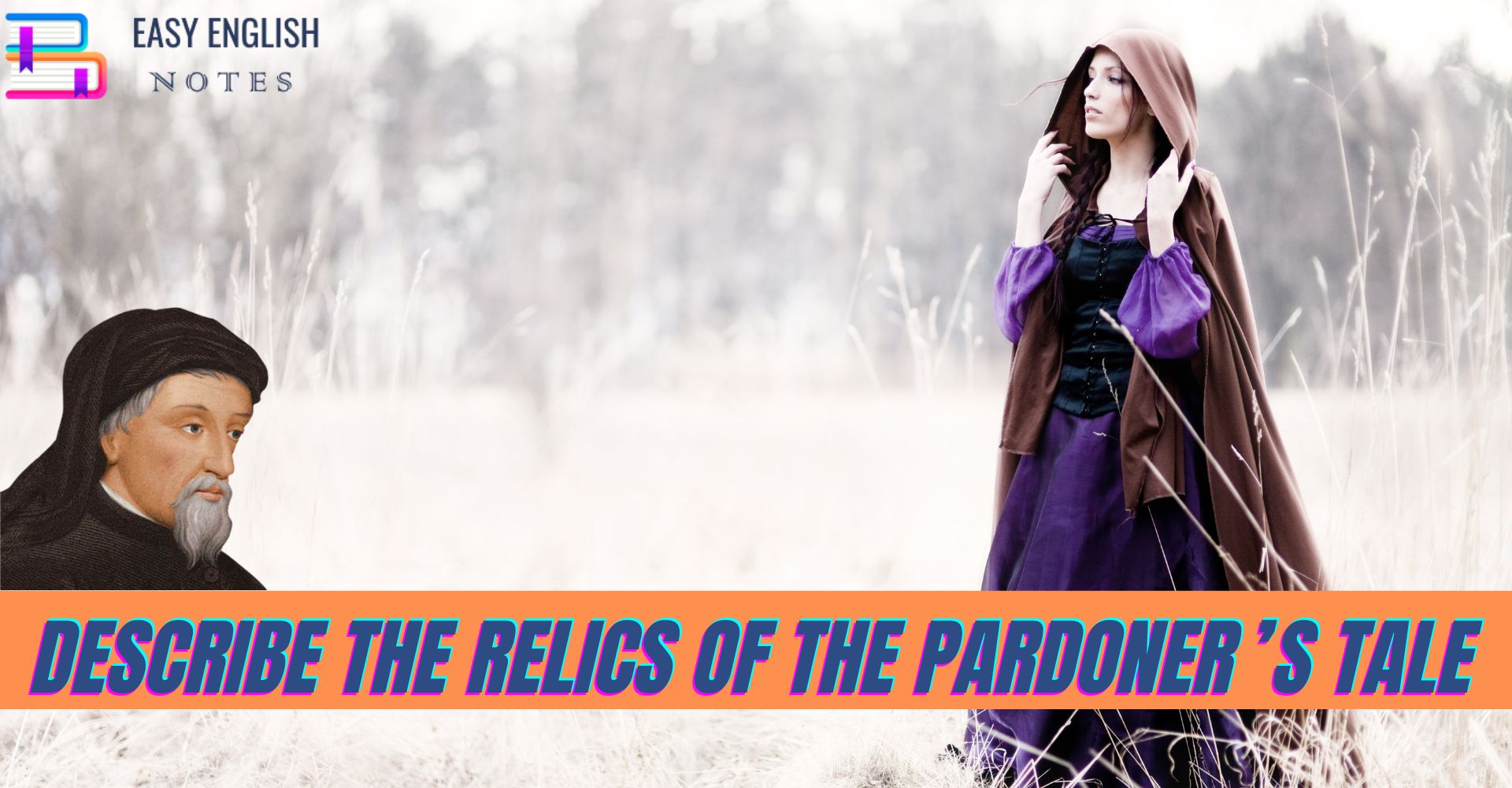The Pardoner is an avaricious man. He earns money by hook or by crook, by fair means or foul, by selling pardons or by persuading the simple folk to touch or kiss the holy miraculous relics. The pardoners in the fourteenth century England Were corrupt and morally bankrupt. They were not allowed to sell pardons, but they did well not to the penitent poor Christians but to the rich prosperous persons and the sellers of victual who, though never repentant, offered him money. He possessed same relics which, he claimed: were holy and miraculous because they were associated with Christ or the Virgin Mary. He claimed that the mere touch of these relics cured illness, jealousy and could bring prosperity.
Roles in the General Prologue: In the General Prologue to The Canterbury Tales there is a mention of some or these relics. The Pardoner keeps in his bag a pillow case which, he says, is the veil of our Lady. He says he has a piece of the sail used St. Peter when he went out upon the sea till Jesus Christ caught him. He has a Cross latten, set with stones, and some pig’s bones in a glass. With these relics, when he finds a poor person he extracts from him more money than that poor person can earn in two months. He thus earns a lot of money.
Relics in The Pardoner’s Tale: There are many relics mentioned in The Pardoner’s Tale. By the help of these relics he can extort a lot of money from even a poor widow who has a string of starving children. The Pardoner describes some of his relics in the following lines:
Thanne shewe I forth my longe cristal stones,
Ycrammed ful of cloutes and of bones-
Relikes been they, as wenen they echoon;
Thanne have I in latoun a sholder-boon;
Which that was of an hooly Jewes sheep.
The glass of the Pardoner is full of rags and bones. They are holy, miraculous relics. He has a shoulder-bone set in brass, of the sheep of a holy Jew. The cow, calf, Sheep or ox will be cured of their diseases if their tongues are washed from the water of the well in which the shoulder-bone is dipped. If a person drinks the water of this well every week in the morning before the cock crows and he breaks his fast, his cattle will multiply. The water of this well can cure even jealousy of the men folk. If a person, burning with jealousy prepares his soup with this water, he will not suspect his wife even though he is acquainted with the loose character of his wife and knows for certain that she has slept with two or three priests.
The Pardoner also displays a mitten (miteyn glove) which has miraculous powers:
Heere is a miteyn eek, that ye may se;
He that his hand wol putte in this mitayn,
He shal have multipliyng of his grayn,
Whan he hath sowen, be it whete or otes,
So that he offre pens, or elles grates.
If a person puts his hand into this glove his crops will multiply even though he has sown wheat or oats.
These relics are false and fake. The Pardoner persuades the simple folk either to touch them or to buy them. That is why Chaucer ridicules the Pardoner. the loose women and the corrupt priests in the first example and the Pardoner and the peasants in the second example. He ridicules the Pardoner because he befools the simple folk. the simple folk because they are foolish, the women because they are unfaithful and the priests because they are immoral. In the second example he ridicules the Pardoner for befooling the simple peasants and the simple peasants for their ignorance and superstitions. The irony lies in the fact that the Pardoner who preaches the persons to discard avarice, persuades and tempts them to become prosperous by buying the mitten.
At the end of the Tale the Pardoner displays to the fellow pilgrims his wallet full of relics. He persuades the pilgrims, pious as they are, to kiss his relics and offer him money. He asks the Host to kiss the relics and offer him money, first of all, as he is most enveloped in sin. The Host gets infuriated and thrashes the Pardoner in the most coarse and abusive language. B.A. Windeatt observes.
The other major concern of Chaucer in his description of the Pardoner’s character is the Pardoner’s use of bogus relics as part of the tricks of his trade. The empty character of the eunuch, and the cheap trickery with which his outwardly holy work is carried on, are the two principal and complementary features of Chaucer’s picture. The Pardoner plays on the simple faith of country priests and their congregations. The medieval reverence for relics and the desire to possess them were so strong that the Pardoner finds easy markets for the old pillow-case which he says is the veil of the Blessed Virgin Mary, or the piece of sail he claims is from the boat from which St. Peter tried to walk on the sea towards Christ (Matthew 14:22-23), or the glass case full of pigs’ bones which he presumably claims as the bones of saints. No wonder Chaucer describes what a splendidly confident figure the Pardoner always cuts in church. For the appearance of self-confidence is essential to the confidence-trickster. And Chaucer‘s Pardoner is an ecclesiastical confidence-trickster. Indeed, it is possible that Chaucer makes him more brazen in his use of false relics than even contemporary pardoners could be. This is literary licence perhaps, to emphasise the nature of the frauds and forgeries of relics that did exist. As a monster, Chaucer’s Pardoner is larger than life.
PLEASE HELP ME TO REACH 1000 SUBSCRIBER ON MY COOKING YT CHANNEL (CLICK HERE)











